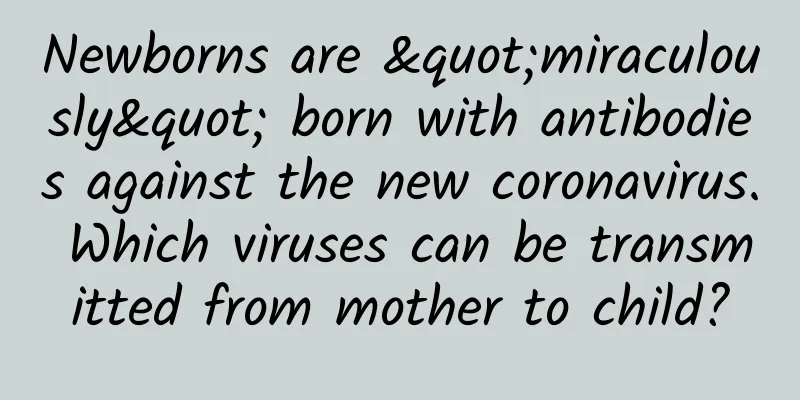Newborns are "miraculously" born with antibodies against the new coronavirus. Which viruses can be transmitted from mother to child?

|
A pregnant woman in Singapore gave birth to a child after being diagnosed with COVID-19, and the newborn was "miraculously" born with antibodies to the virus. What viruses can be transmitted from mother to child? And what are the ways to block them? Written by reporter Lai Tianying (Medical and Health Group) Graphic editor/Chen Yongjie New media editor/Chen Xuanzhi Interview experts: Wang Qi (Chief Physician of Obstetrics Department, Beijing Obstetrics and Gynecology Hospital, Capital Medical University) Recently, according to Singapore's Straits Times, a pregnant woman in Singapore gave birth to a child after being diagnosed with COVID-19, and the newborn "miraculously" had antibodies to the virus. Not only that, the new coronavirus in the pregnant woman's body also magically "disappeared". Medical staff have not yet detected active new coronavirus in amniotic fluid or breast milk samples. Newborns have antibodies to the virus? What viruses can be transmitted from mother to child? What are the means to block it? ▲A pregnant woman in Singapore gave birth to a child after being diagnosed with COVID-19, and the newborn "miraculously" had antibodies to the virus (picture from the Internet) Babies' own COVID-19 antibodies are "passive immunity" In fact, at the beginning of the year when the epidemic was at its worst in my country, there were reports that COVID-19 antibodies could be detected in newborns born to infected people. Wuhan University Zhongnan Hospital detected antibodies in the serum of six newborns. On April 8, Wu Ying, a pregnant woman infected with COVID-19 in Inner Mongolia, successfully gave birth to a baby girl nearly two months after she was cured. IgG antibodies to the coronavirus were detected in the baby's blood. In medicine, this situation is called "passive immunity" because the antibodies are not produced by the mother. Usually, the mother passes her own antibodies to the baby through the placenta, causing the baby's IgG to increase. ▲On July 11, 2020, Zhao Yangyu, director of obstetrics and chief physician at Peking University Third Hospital, introduced whether pregnant women can continue their pregnancy after pregnancy complicated by COVID-19 (Picture from the Internet) On April 14, Academician Qiao Jie, leader of the Peking University National Medical Team to Hubei to fight the epidemic, told the media that, based on reports from home and abroad, the results of throat swab tests of babies born to those who have recovered from COVID-19 were all negative. In fact, after analyzing the samples, it was found that a small number of newborns were able to obtain an immunoglobulin, IgG antibody, from their mothers. In other words, when a cured person who has been infected with COVID-19 is nurturing a new life, there is a certain probability that he or she can provide virus antibodies to the newborn, giving it immunity from birth. In October, doctors from New York Presbyterian Church and Columbia University Irving Medical Center published an article in the Journal of the American Medical Association Pediatrics, saying that mother-to-child transmission of the coronavirus is rare. Previously, there was a precedent in Shenzhen where a pregnant woman with asymptomatic coronavirus infection gave birth to a baby boy with antibodies. Antiviral drugs block mother-to-child transmission of HIV Although we still know very little about the new coronavirus, there are many diseases that are indeed transmitted from mother to child, and AIDS is one of them. It is a very harmful infectious disease caused by infection with the human immunodeficiency virus (HIV). HIV is a virus that can attack the human immune system. It targets the most important CD4+T lymphocytes in the human immune system, destroying them in large numbers and causing the body to lose its immune function. Wang Qi, chief obstetrician at Beijing Obstetrics and Gynecology Hospital affiliated to Capital Medical University, said that AIDS is mainly caused by a virus. The first route of transmission is sexual intercourse, which is sexual transmission. The second route is blood transmission, which means transmission through blood transfusion or blood contact. The third route is mother-to-child transmission. The placenta itself has a certain barrier function. It can block some bacteria and some microorganisms to ensure that the mother will not transmit the virus to the child. However, the placenta has no blocking effect on some viruses. It is for this reason that viral infectious diseases such as AIDS can be directly transmitted to the fetus through the placenta carrying the AIDS virus, leading to fetal infection. "During pregnancy, the degree of immunodeficiency of the mother during infection and the HIV viral load in the mother are important factors that determine transmission," Wang Qi explained. "During delivery, especially vaginal delivery, direct contact with blood and secretions can also cause infants to be infected with HIV. Placental abruption and perineal tearing during delivery will increase the contact time between the newborn and the mother's blood and body fluids, increasing the risk of mother-to-child transmission of HIV." Breastfeeding can also greatly increase the risk of mother-to-child transmission of HIV. Studies have shown that 30% of infants infected with HIV are infected during pregnancy, 50% are infected during delivery, and the risk of infection during breastfeeding is 20%. At present, medicine has been able to block the transmission of the virus from mothers carrying HIV to their babies. Among them, antiviral drugs can reduce the viral load in the mother's body fluids and are effective in preventing mother-to-child transmission of HIV. Currently, drugs commonly used to prevent mother-to-child transmission of HIV include zidovudine and lamivudine. In addition, mothers with AIDS can choose to have a cesarean section to reduce the risk of mother-to-child transmission. Feeding methods can be changed during lactation, including avoiding breastfeeding, sterilizing breast milk, and stopping breastfeeding when the breasts are swollen or the nipples are cracked. Wang Qi said that my country has implemented free AIDS testing in some major cities, and mothers with AIDS before pregnancy are advised to receive effective treatment before preparing for pregnancy. If AIDS is discovered after pregnancy, especially in the early stages of pregnancy, it should be immediately treated at a regular infectious disease hospital to reduce the risk of the fetus being infected with AIDS. By the end of 2017, the detection rate of HIV in pregnant women in my country had reached over 95%, and the strategy implemented by the project was very effective. At present, the antiretroviral treatment rate of pregnant women infected with HIV and their children has reached over 90%. The focus of the prevention of mother-to-child transmission of HIV is now on poor areas with a relatively high incidence of HIV. The local infrastructure is poor, and there is a shortage of health workers, obstetricians, and pediatricians. The prevention of mother-to-child transmission of HIV still faces relatively severe challenges. Drugs, vaccines work together to block transmission of hepatitis B virus my country is a country with a high prevalence of hepatitis B. There are many chronic virus carriers, resulting in a high incidence of hepatitis B and liver cancer, which seriously threatens human health. Perhaps some people have noticed that hepatitis B has a high degree of family clustering. It has many ways of transmission, including blood transmission, sexual transmission, close life transmission, mother-to-child transmission, etc. Studies have found that about 1/3 of hepatitis B surface antigen carriers are from mother-to-child transmission. The hepatitis B virus in the mother's body may infect the child before or at birth, making the child infected with hepatitis B virus at birth. Wang Qi said, "The infection routes of hepatitis B virus and HIV are almost the same, especially in my country, where there are a large number of hepatitis B virus carriers. Therefore, my country has taken very strong measures to prevent and treat hepatitis B virus. We recommend that hepatitis B virus carriers or hepatitis B patients must be evaluated before pregnancy. If the viral load is too high or accompanied by liver damage, active treatment should be taken to reduce the viral load to a relatively low level before pregnancy." "Especially if there are early-stage liver cirrhosis or even some serious complications such as varicose veins, pregnancy is not recommended. Because once pregnant, the liver is overloaded, causing severe hepatitis, prone to miscarriage or premature birth, and even causing maternal death." The Clinical Guidelines for the Prevention of Mother-to-Child Transmission of Hepatitis B Virus (2020) points out that mother-to-child transmission of hepatitis B virus is the main cause of chronic hepatitis B in my country, and preventing mother-to-child transmission of hepatitis B virus is the key to controlling chronic hepatitis B. Mothers with hepatitis B must systematically monitor the viral load during pregnancy, and give antiviral treatment after 28 weeks of pregnancy based on the viral load. After the birth of the newborn, active and passive immunization measures should be taken immediately, and hepatitis B immunoglobulin and hepatitis B vaccine should be given in time within 24 hours. Wang Qi told reporters that mothers with hepatitis B must pay attention to pre-pregnancy checkups, systematically assess their physical condition under the joint guidance of hepatitis B virus treatment specialists and obstetricians, and prepare for pregnancy after reaching a reasonable level. During pregnancy, it is necessary to closely monitor changes in the condition and go to a technically capable hospital for prenatal checkups and delivery. New discovery of mother-to-child transmission of H5N1 avian influenza Avian influenza, commonly referred to as bird flu, is a highly contagious disease of poultry caused by influenza A virus and is classified as a Category A infectious disease by the International Veterinary Office. Chinese scientists have found that H5N1 avian influenza can be transmitted from mother to child in addition to being transmitted through the respiratory tract. ▲Studies have shown that the H5N1 avian influenza virus can pass through the placental barrier and be transmitted to the fetus. (Picture from the Internet) Professor Gu Jiang, Dean of Peking University's School of Basic Medical Sciences and Director of the Department of Pathology, led a research team that conducted nearly two years of experimental research on two bodies that died of H5N1 avian influenza. They found that in addition to infecting the lungs, the avian influenza virus also attacks multiple organ cells such as the human trachea, digestive tract (intestines), and neurons in the brain. This discovery overturned the previous assertion that the avian influenza virus only exists in the lungs. Of the two corpses obtained by the research team, one was a 24-year-old pregnant woman. The research team found that the virus was present in the placenta of the pregnant woman and in the lungs of the fetus. This shows that the virus can pass through the placental barrier and be transmitted to the fetus. The fact that the pregnant woman infected the fetus proves that the virus did not enter through the respiratory tract but through the blood, indicating that the virus has other transmission routes besides the respiratory tract. Professor Gu Jiang said that although the fetus is not a person in the usual sense, it is a fetus in the mother's body, and when it is born, it is a person with different genes and phenotypes from the mother. If the virus has the ability to infect the fetus, it is likely to have the ability to infect newborns, children and adults. With the increasing number of human cases of H5N1 avian influenza, this highly pathogenic virus is prone to large-scale outbreaks if it is not prevented in time. References: Zhang Weicheng. The mystery of the origin of AIDS[J]. Youth Science and Technology Expo, 2003(8):30-31. Yang Ke, Han Hongyu, Pu Daifen. Study on the effect of artificial interruption of mother-to-child transmission of HIV/AIDS[C]// Guizhou Preventive Medicine Association Academic Annual Meeting and Forum on Infectious Disease Prevention and Control and Public Health Talent Training. Yang Huixia, Hu Yali, Liu Xinghui, et al. Clinical guidelines for prevention of mother-to-child transmission of hepatitis B virus (2020)[J]. Journal of Clinical Hepatobiliary Diseases, 2020(7):1474-1481. Chinese scientists found that avian influenza virus can be transmitted from mother to child https://health.sohu.com/20071025/n252861540.shtml Produced by: Science Central Kitchen Produced by: Beijing Science and Technology News | Science Plus Client Reproduction without authorization is prohibited, and offenders will be prosecuted |
<<: @All parents, protect our sacred beasts! The Norovirus, scarier than the Big Bad Wolf, is here
>>: If you are in any of these 3 situations, do not undergo myopia surgery!
Recommend
Why do I have brown discharge during my period?
Every woman's physical condition is different...
What causes women's lower abdomen pain
Women sometimes feel very strange about a phenome...
Scientific understanding of alum in food
Golden and crispy fried dough sticks are a common...
What to do if you have abdominal pain after your period
There will be symptoms of abdominal pain after me...
Another breakthrough in AI! 10 types of dementia are diagnosed simultaneously, increasing the accuracy of human doctors by 26%
Written by | Ma Xuewei Preface Dementia is curren...
Weird hypothermia: from agitation to hallucinations
Nowadays, the climate in many parts of the world ...
What to do if you feel dizzy during your period
During menstruation, different women may experien...
What medicine should be used for itchy tofu dregs secretion
The occurrence of abnormal phenomena such as leuc...
What are the best treatments for functional uterine bleeding?
Dysfunctional uterine bleeding is a common proble...
What are the symptoms of low blood pressure in women
If our body's physical signs are represented ...
What causes adenomyosis?
I believe that women are not unfamiliar with aden...
6 free tips to treat dysmenorrhea
Tip 1 for dysmenorrhea: Watch comedy to relax you...
What is menopausal vaginitis?
It should be noted that even female friends in me...
Can I eat blood supplements during menstruation?
Menstruation is a normal physiological period tha...









